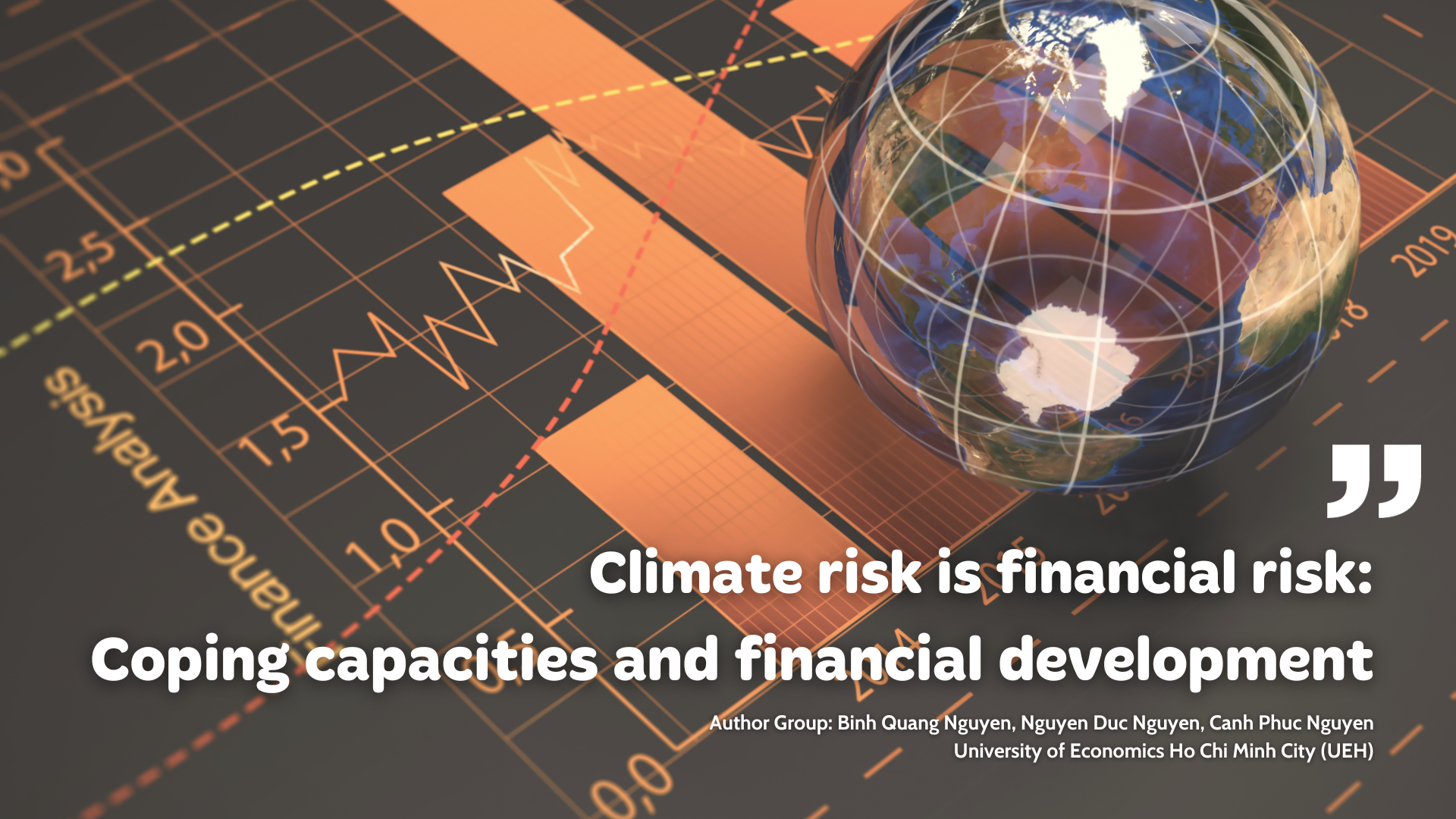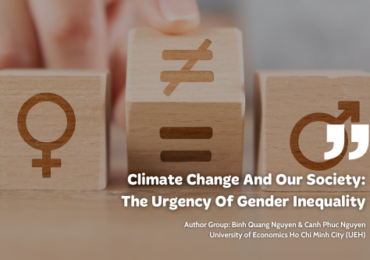Climate risk is financial risk: Coping capacities and financial development
22 November, 2023
According to the report of The Intergovernmental Panel on Climate Change in 2023, there are approximately 3.3 to 3.6 billion people suffering from severe threats of climate changes’ consequences (such as storms, heatwaves, earthquakes). From financial perspectives, there have been lively discussion and broad agreement indicating that climate risk is closely associated with financial risk. This article aims to explore whether climate risks matter for the development of financial systems using a global sample of 130 countries worldwide. To fulfill this objective, the authors employ a new database which covers various facets of financial development. Notably, this article shows the heterogeneity in the effects of the capability to cope with natural hazards on the development of financial systems.
 Emerging literature suggests that climate change causes a rise in financial risk (Wagner, 2022). Given that the frequency of natural hazards is increasing in recent years, the incapability to cope with extreme natural disasters might lead to various social and economic consequences.
Emerging literature suggests that climate change causes a rise in financial risk (Wagner, 2022). Given that the frequency of natural hazards is increasing in recent years, the incapability to cope with extreme natural disasters might lead to various social and economic consequences.
Given the inherent unpredictability of climatic changes, which ultimately causes systematic disorders and exacerbate uncertainties among economic agents in an economy, the optimal approach for a country to address this issue is to enhance its resilience to natural hazards. By doing so, it is possible to gain the long-term confidence regarding the capability to cope with various natural hazards resulted from climate changes. Conversely, greater exposure to climate risk would lead to the more detrimental influences due to the limited ability of econmic entities to effectively manage and respond. This article provides a global view of the influence of a national incapacity to cope with natural hazards on its financial development.
Climate change and impacts on financial system
Rich literature has emerged studying the impacts of climate risk on various dimensions of the financial system. For instance, Chang and Berdiev (2013) concluded that the occurrence of natural disasters and the loss of life caused by natural disasters are associated with a significant rise in insurance consumption. Klomp (2014) found that natural catastrophes may elevate the likelihood of failures among commercial banks in a sample of 160 nations spanning the period from 1997 to 2010. Recently, Do, Phan, and Nguyen (2022) highlighted the detrimental impact of natural catastrophes on the stability of banks by using a sample of 907 domestic/local US banks, covering the period from 2010 to 2019.
Natural disasters also bear a negative effect on the financial market. For example, observing 42 severe extreme weather events (such as storms, floods, cyclones, earthquakes, and bushfires) and the Australian equity market, Worthington and Valadkhani (2004) concluded that extreme natural events may exert positive and/or negative influences on market returns on the day of the event. With respect to the financial institution sector, Collier and Skees (2012) reported that financial intermediaries in Peru used insurance against El Niño to protect themselves from natural disaster risk. The susceptibility of a financial system, (consists of financial institutions and financial markets), to climate risk should be indicated by countries’ ability to cope with climate risk rather than the ability to resolve severe natural disasters’ damages.
On the supply side, it can be argued that climate risk poses a systemic threat to the overall economy. Climate risk may be considered a comprehensive risk that arises from the interplay, interconnectedness, and evolution of multiple dangers. Consequently, it may be anticipated that economic activities, particularly long-term economic growth, will be adversely affected by the escalation of climate risk, characterized by its inherent nature of uncertainty and potential negative consequences (Mendelsohn, 2009). On the demand side, the escalation of climate risk may potentially have substantial adverse effects. The rise of climate risk, characterized by its inherent uncertainty, can potentially diminish economic activity, increase unemployment rates, lower consumption levels, and impede investment decisions made by economic actors. The escalation of climate risk may serve as a catalyst for economic agents to prioritize savings above investments (Huang & Wu, 2018).
Multidimensional financial development: A new way to measure financial development
Recently, based on the information from the International Monetary Fund, Svirydzenka (2016) has introduced a new database of multidimensional financial development. Remarkably, this database separates two distinct essential components of the financial system which are financial institutions, and financial markets.
For each component, the authors propose and measure three distinct dimensions, namely: (i) financial efficiency, (ii) financial access, and (iii) financial depth. Therefore, there exists nine indicators for our analysis: overall financial development, development of financial institutions, development of financial markets, financial institutions efficiency, financial institutions access, financial institutions depth, financial markets efficiency, financial markets access, and financial markets depth. This new database of financial development provides a new avenue for studies targeting the development of the financial system.
Climate Risk and multidimensional Financial Development: Some new evidence
Our study aims to conduct empirical analysis targeting the impacts of climate risk on financial development for a large sample covering 130 countries from 2011 to 2019. In term of climate risk, this study employs the lack of coping capacities to natural hazards index from the World Risk Reports prepared by Hilft (2020).
Using the panel quantile regression, our empirical findings have shown that inadequate coping capabilities with climate risks has a detrimental impact on financial development. Furthermore, the lack of coping capacities has significantly negative impacts on both financial institutions and financial markets in the global sample and the sub-sample of countries with the high level of exposing to climate risk. Interestingly, the effects are insignificant in the sub-sample covering countries with the low level of climate risk. Finally, when estimating the simultaneous effects of climate risk on three dimensions of two components of financial development, this research find that the lack of coping capacities to climate risks has predominantly adverse effects on all aspects of the two sub-sectors.
Some implications
Our empirical findings suggest that a notable hindrance to achieve financial development is the insufficient capacity to cope, particularly in nations characterized by low levels of financial development. Besides, the absence of coping capabilities might exert adverse effects on the progress of financial institutions and financial markets. This implies that financial system, especially in developing countries, should consider climate risks in their risk management model. Furthermore, governments should pay a serious attention to strengthen capabilities to coping and adapting with climate change to for both economic and financial development.
References
Chang, C. P., & Berdiev, A. N. (2013). Natural Disasters, Political Risk and Insurance Market Development. The Geneva Papers on Risk and Insurance – Issues and Practice, 38(3), 406-448. doi:10.1057/gpp.2013.14
Collier, B., & Skees, J. (2012). Increasing the resilience of financial intermediaries through portfolio-level insurance against natural disasters. Natural Hazards, 64(1), 55-72. doi:10.1007/s11069-012-0227-0
Do, Q. A., Phan, V., & Nguyen, D. T. (2022). How do local banks respond to natural disasters? The European Journal of Finance, 1-26. doi:10.1080/1351847X.2022.2055969
Hilft, B. E. (2020). WorldRiskReport 2020. Retrieved from Berlin, Germany: https://weltrisikobericht.de/english/
Huang, J.-T., & Wu, L. (2018). Climate Volatility and Household Saving in China. Journal of Financial Counseling and Planning, 29(1), 132-141. doi:10.1891/1052-3073.29.1.132
Klomp, J. (2014). Financial fragility and natural disasters: An empirical analysis. Journal of Financial Stability, 13, 180-192. doi:https://doi.org/10.1016/j.jfs.2014.06.001
Klomp, J. (2016). Economic development and natural disasters: A satellite data analysis. Global Environmental Change, 36, 67-88. doi:https://doi.org/10.1016/j.gloenvcha.2015.11.001
Mendelsohn, R. (2009). Climate change and economic growth: World Bank Washington, DC.
Nguyen, C. P., Nguyen, N. D., & Wongchoti, J. (2023). A look beyond climate risk exposure: the impact of incapacity to cope with natural hazards on financial development. Environmental Science and Pollution Research, 30(20), 58058-58076. doi:10.1007/s11356-023-26621-1
Svirydzenka, K. (2016). Introducing a new broad-based index of financial development (Vol. IMF Working Paper): International Monetary Fund.
Wagner, G. (2022). Climate risk is financial risk. Science, 376(6598), 1139-1139. doi:doi:10.1126/science.add2160
Worthington, A., & Valadkhani, A. (2004). Measuring the impact of natural disasters on capital markets: an empirical application using intervention analysis. Applied Economics, 36(19), 2177-2186. doi:10.1080/0003684042000282489
Please refer to the full paper “A look beyond climate risk exposure: the impact of incapacity to cope with natural hazards on financial development” HERE.
Author Group: Binh Quang Nguyen, Nguyen Duc Nguyen, Canh Phuc Nguyen, University of Economics Ho Chi Minh City (UEH)
This is an article in the series of articles spreading research and applied knowledge from UEH with the “Research Contribution For All – Nghiên Cứu Vì Cộng Đồng” message, UEH cordially invites dear readers to look forward to the upcoming Knowledge Newsletter ECONOMY No. #99.

News & photos: Author, UEH Department of Marketing & Communication





































